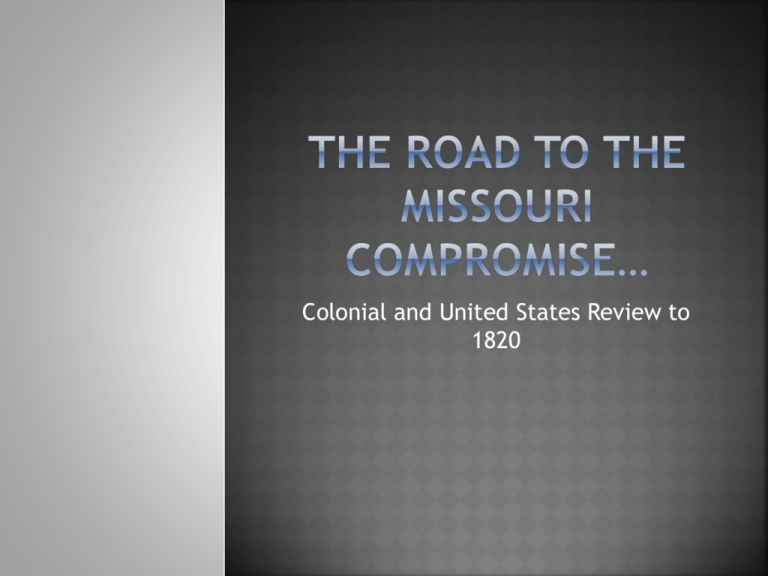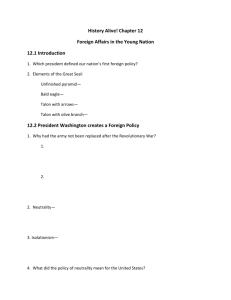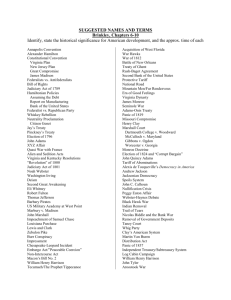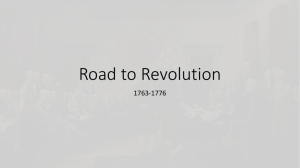The Road to the Missouri Compromise
advertisement

Colonial and United States Review to 1820 a. Identify the reasons for colonization, evaluate its impacts, and analyze the success or failure of settlements in North America b. Analyze religious development and its significance in colonial America (e.g., religious settlements, the Great Awakening) c. Describe significant aspects of the variety of social structures of colonial America d. Compare the economies of the various colonies, and analyze the development and impact of indentured servitude and African slavery in North America (e.g., social, political, and economic) e. Explain the origins and development of colonial governments f. Evaluate the influence of Enlightenment ideas on the development of American government as embodied in the Declaration of Independence Huge population growth from 17001775 (300,000-2.5 million) Youthful population – average age by 1775 was 16 Most populous colonies – Virginia, Massachusetts, Pennsylvania, North Carolina, Maryland VA –established For purpose of Economic profit MA- very religious 2 important events paved the way for revolutionist ideas 1. 1730’s-1740’s a revival of religion which became known as the IMPORTANCE The Great Awakening was a movement rooted in spiritual growth which brought a national identity to Colonial America. The major effect of the Awakening – it encouraged people to question authority and think for themselves. Spilled over in political matters. 2. French and Indian War-1754-1763 •Conflict between British and French Over land in America Importance •Colonist questioned strength Of British army •French and Spanish lost lands •Native Americans lost ground •Proclamation of 1763 -prohibited colonists From settling lands west of Appalachian mts. •Colonist ignored this March 5, 1770 Boston Massacre British soldiers fire on citizens (Crispus Attucks died) 1773 – Tea Boston Tea Party 1765 Quartering Act 1767 Townshend Acts –tax to pay salaries of governors and judges 1774 Intolerable Acts -Boston Port closed -Troops in Boston -Restriction of town meetings 1765 Stamp Act (Repealed in 1766) 1766 Declaratory Act – absolute sovereignty over colonies April 1775 Lexington and Concord British troops fire on colonial militia 1764 Sugar Act – taxes on foreign sugar Explain the cartoon . •Ben Franklin’s drawing is considered to be the first political cartoon in American History 1. Using maps on page 85 and 92, answer the provided questions. The maps deal with immigrant groups in 1775 and the colonial economy. 2. Using the prints of the Boston Massacre on page 129 and the account of the massacre on pages 129-130, answer the provided questions. 1st Continental Congress • 1774 • Wrote letters to the King and Parliament 2nd Continental Congress • 1775 • Convened right after the Battle of Lexington and Concord • Appointed George Washington leader of a colonial army 1776 • Thomas Jefferson wrote the Declaration of Independence • It was approved on July 2, 1776 Washington Crossing the Delaware Painted by Emanuel Leutze, 1851 British surrender at Yorktown - 1781 Treaty of Paris 1783 – formally ended the war between the Colonists and the British Cornwallis’ Surrender at Yorktown: “The World Turned Upside Down!” Painted by John Trumbull, 1797 Wholesale Price Index: 1770-1789 Articles of Confederation (1781-1787) Northwest Ordinance of 1787 One of the major accomplishments of the Confederation Congress! Statehood achieved in three stages: 1. Congress appointed 3 judges & a governor to govern the territory. 2. When population reached 5,000 adult male landowners elect territorial legislature. 3. When population reached 60,000 elect delegates to a state constitutional convention. Result – calls for a Stronger federal govt Shays’ Rebellion: 1786-7 There could be no stronger evidence of the want of energy in our governments than these disorders. -- George Washington 55 men – lawyers, merchant, shippers Held in secret in Philadelphia James Madison – Father of Constitution Absent : Thomas Jefferson, John Adams, Thomas Paine, Samuel Adams, John Hancock, and Patrick Henry You will receive a packet with readings and assignments on the following topics: 1. timeline of the American Revolution and activity 2. The Stamp Act 3. The Boston Tea Party 4. The Intolerable Acts 5. The First Continental Congress 6. Lexington and Concord 7. The Second Continental Congress 8. Signers of the Declaration 9. The Articles of Confederation 10. The Treaty of Paris *This assignment is due on Wednesday Virginia Plan Representation based on Population New Jersey Plan Representation based on equality Great Compromise House of Representatives Senate Based on Population Based on Equal Representation (2 per state) Executive Carries out laws Legislative Makes Laws Judicial Interprets Laws Three Branches of Government Federalists Antifederalists You will receive a copy of George Washington’s farewell in 1796. Read the Farewell Address and annotate. Be prepared to discuss its importance in 1796, as well as for the future. Federalists and Democratic Republicans (John Adams/Thomas Jefferson) George Washington stepped down after his 2nd term 1797-1801 John Adams 1801-1809 Thomas Jefferson Louisiana Purchase 1803 ($15 million) 1807 – End of the slave trade Thomas Jefferson 1801-1809 Issues with England on the high seas 1804 – Lewis and Clark expedition to the Northwest (Sacajawea) Jeffersonian Era Father of the Declaration of Independence Began the Democratic-Republican Party 2nd Vice President of the US (Jon Adams) 1st Secretary of State under Washington Minister to France Governor of Virginia Founded University of Virginia 3rd president of the USA How does this qualify as a primary document? What do we know about Sandy from this advertisement? What does this advertisement tell us about Thomas Jefferson? 1. Read Opportunity Knocks: Jefferson Responds and answer the accompanying questions. This document deals with the Louisiana Purchase. 2. Read The Lewis and Clark Expedition and complete the Lewis and Clark quiz. Highlights of his presidency War of 1812 – against Britain (burned DC) Battle of Orleans – led by Andrew Jackson defeated British troops Ended the Federalist Party Encouraged growth of industry Confirmed US a free nation 1817-1825 Era of Good feelings (1 political party dr) Panic of 1819- banks fail 1819- Florida ceded to the US from Spain Monroe Doctrine 2. After reading about the Monroe Doctrine, answer the following questions in your notes: 1. What was the original reason for developing the Monroe Doctrine? Explain the Monroe Doctrine. 3. What was an immediate effect of the Monroe Doctrine? Originally, colonies used labor known as indentured servitude. White servants were “employed” with passage paid to the colonies from England. There was a surplus of people needing work. The Head right system developed. For every person provided passage to the colonies, 50 acres of land would be given to the master. However, indentured servants weren’t ideal because eventually they were to receive freedom after years of work. 1492-1792 400,000 Africans to North America North – trade/fishing South – agriculture/plantations By 1662, slave codes were established in Virginia Captured on western portion of Africa Triangular trade/middle passage South slave based agriculture North commerce






